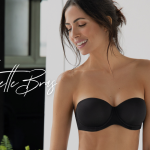
What Do The Numbers And Letters In a Bra Size Refer To?
We know you too must always get confused by seeing all the numbers and letters that a bra has. No worries, ladies; every woman is sailing in the same boat, and we were too at some point before. A recent study claims that 8 out of 10 women wear the wrong sized bra as a result of this confusion. In this article, we’ll break down these components and explain to you what these numbers and letters suggest. With this knowledge, you’ll be one step closer to finding the perfect fit!
Understanding cup size
Cup size is the measurement of a bra’s cup, which is the front part that covers the breasts. The letter (A-I) associated with cup size indicates the volume of the cup and ranges from A to I, with A being the smallest and I being the largest. The difference between two cup sizes is usually about 1 inch, while the difference between two band sizes is usually 4 inches.
Exploring band size
The band size, which is indicated by a number such as 28-44, corresponds to the measurement around the ribcage and typically increases with a larger frame. It’s important to get an accurate measurement for your band size, as a snug fit will provide better support for the breasts and prevent sagging or slippage. The band should fit securely without digging into the skin; if it’s too loose or too tight, it won’t be providing the right amount of support.
Breakdown of letter sizes
The letters refer to the volume or capacity of the cups, with a B cup being larger than an A cup. This is because a B cup supports more volume than an A cup. To make sure you get the best fit for your body type, it’s important to understand how each letter size corresponds to different amounts of breast tissue. For example, an A cup generally fits someone with petite breasts, while a DD or DDD cup typically fits someone with fuller breasts.
How to measure bra cup size
Step 1.
Measure your band size: Start by measuring the circumference of your rib cage, directly under your breasts. Make sure the measuring tape is snug but not too tight. Record the measurement. This is your band size. If the measurement comes in an odd number, round it up to the nearest even number. For example, if your measurement is 33 inches, round it to the whole even number, which is 34, and that is your final band size measurement.
Step 2.
Measure your bust: Find a measuring tape and measure around the fullest part of your bust. Remember to wear an unpadded bra while measuring for the most accurate results.
Step 3.
Calculate your bra cup size: The band size is your rib cage measurement in inches. The bust size is your bust measurement in inches. Subtract your band size from the bust size to get the cup size. For example, if the band size is 32 inches and the bust size is 36 inches, then the difference will be 4, which means your cup size is 32D.
The chart below refers to the bra cup size:

It’s important to note that letter sizes can vary between brands and styles as well. Therefore, it’s important to check out each brand’s size chart before making a purchase and select according to their guidelines.
Interpreting number sizes
Bra sizes are typically indicated by two numbers, with the first number representing the band size and the second number representing the cup size. The band size of a bra is indicated by a number, usually ranging from 28 to 44. This measurement is taken around the ribcage, just below the breasts.
The cup size of a bra is indicated by a letter, usually ranging from AA to DDD (or even higher). The letter size corresponds to different amounts of breast tissue and varies between brands and styles. To ensure an accurate measurement of your cup size, it is best practice to try on multiple styles and use a tape measure when possible.
To calculate your overall bra size, you need two measurements: one around your rib cage for your band size and one around the fullest part of your bust for your cup size. The difference between these two measurements determines your cup size; if it falls between sizes, it’s recommended to round up for maximum comfort. If you are getting an even number, then that is your band size, and if it is an odd number, then round it to the nearest inch to get your size.
By following these steps, you will be well-equipped to find the perfect-fitting bra for your body type and needs.





Leave a Reply